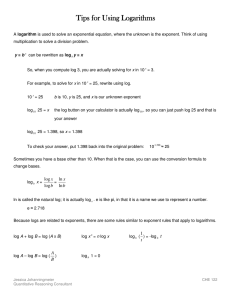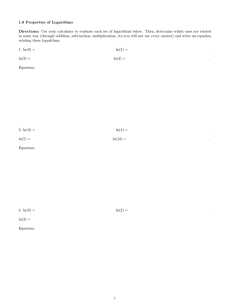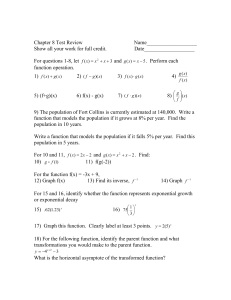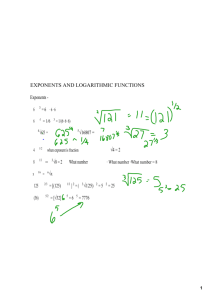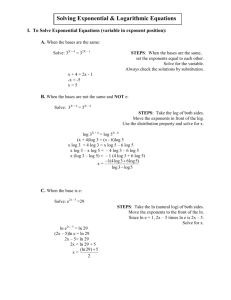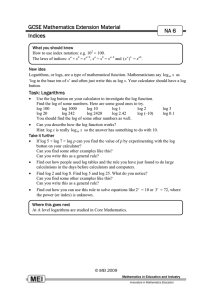Logarithms
advertisement
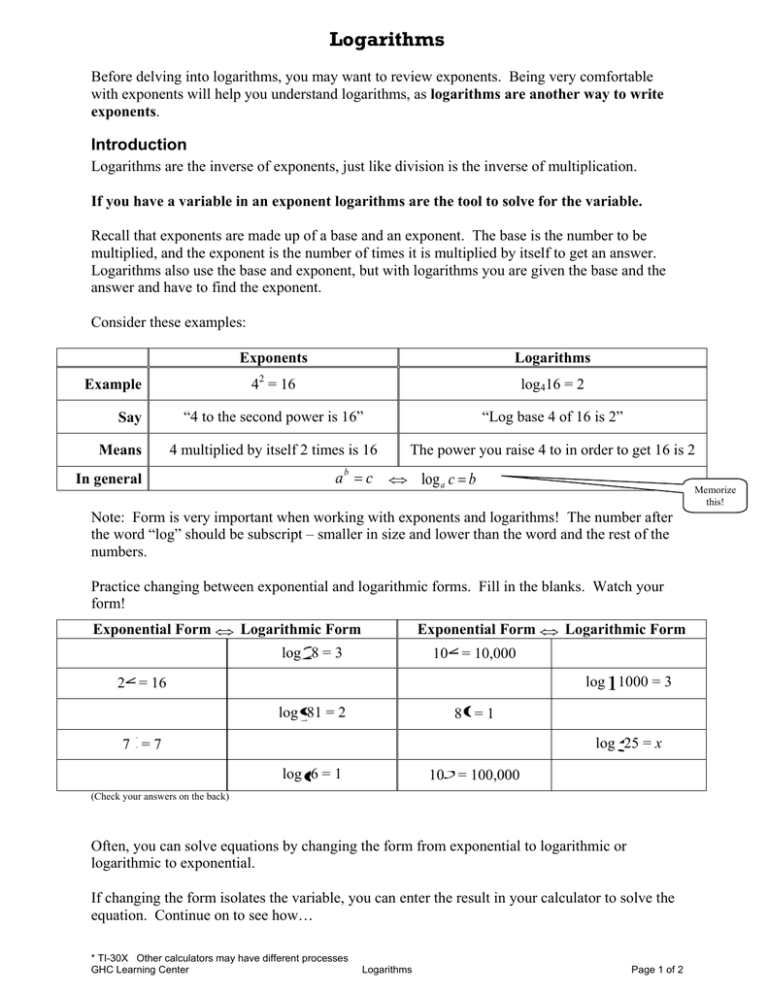
Logarithms Before delving into logarithms, you may want to review exponents. Being very comfortable with exponents will help you understand logarithms, as logarithms are another way to write exponents. Introduction Logarithms are the inverse of exponents, just like division is the inverse of multiplication. If you have a variable in an exponent logarithms are the tool to solve for the variable. Recall that exponents are made up of a base and an exponent. The base is the number to be multiplied, and the exponent is the number of times it is multiplied by itself to get an answer. Logarithms also use the base and exponent, but with logarithms you are given the base and the answer and have to find the exponent. Consider these examples: Exponents Logarithms 42 = 16 log416 = 2 “4 to the second power is 16” “Log base 4 of 16 is 2” 4 multiplied by itself 2 times is 16 The power you raise 4 to in order to get 16 is 2 Example Say Means In general ab = c ⇔ log a c = b Memorize this! Note: Form is very important when working with exponents and logarithms! The number after the word “log” should be subscript – smaller in size and lower than the word and the rest of the numbers. Practice changing between exponential and logarithmic forms. Fill in the blanks. Watch your form! Exponential Form ⇔ Logarithmic Form Exponential Form ⇔ Logarithmic Form 104 = 10,000 log2 8=3 24 = 16 log10 1000 = 3 80 =1 log9 81 = 2 71 =7 log5 25 = x 10 x = 100,000 log6 6=1 (Check your answers on the back) Often, you can solve equations by changing the form from exponential to logarithmic or logarithmic to exponential. If changing the form isolates the variable, you can enter the result in your calculator to solve the equation. Continue on to see how… * TI-30X Other calculators may have different processes GHC Learning Center Logarithms Page 1 of 2 Using Your Calculator* If by changing forms you end up with something like this: 92 =x 104 =x x = 83 You can find an answer quickly on your calculator like this: 9 ^ 2 x = 173 or Your answer should be: = 81 If by changing forms you end up with something like this: log9 81 = x log10 10000 = x x = log8 512 or x = log17 4913 You can still use your calculator to get an answer. Enter the log of the big number (big in size, not big numerically), divided by the log of the small number (small in size, not small numerically). This uses the “change of base” formula. For example, log9 81 = x would be entered into the calculator as follows: Your answer should be: LOG log 8 1 ) LOG ÷ 9 2 = Don’t forget to enter this parenthesis. Your calculator will automatically enter the other required parentheses. Solve these using your calculator: 65 log3 27 182 log2 256 53 log5 625 1 log16 4 92 (Check your answers below) Special Logs If a base is not indicated on a log, the base is 10. Log500 means log10 500 (log base 10 of 500). LN (log naturalis, commonly called “natural log”) means loge (log base e). “e” is just a number (approx. 2.718) that can be raised to a power on your calculator. ln25 (natural log of 25) means loge 25 (log base e of 25). Answers Exponential Form 3 =8 24 = 16 92 = 81 71 =7 61 =6 2 ⇔ Logarithmic Form 8=3 2 log2 16 = 4 log 9 log7 7=1 log6 6=1 log 81 = 2 Exponential Form ⇔ Logarithmic Form 4 = 10,000 103 = 1000 80 =1 5x = 25 10 x = 100,000 10 log10 1000 = 3 log8 1=0 log5 25 = x log10 100000 = x 10 * TI-30X Other calculators may have different processes GHC Learning Center log 10000 = 4 Logarithms Using Your Calculator 5 182 53 6 1 92 3 3 256 2 8 5 log16 4 4 7776 log 27 324 log 125 log 625 3 .5 Page 2 of 2
